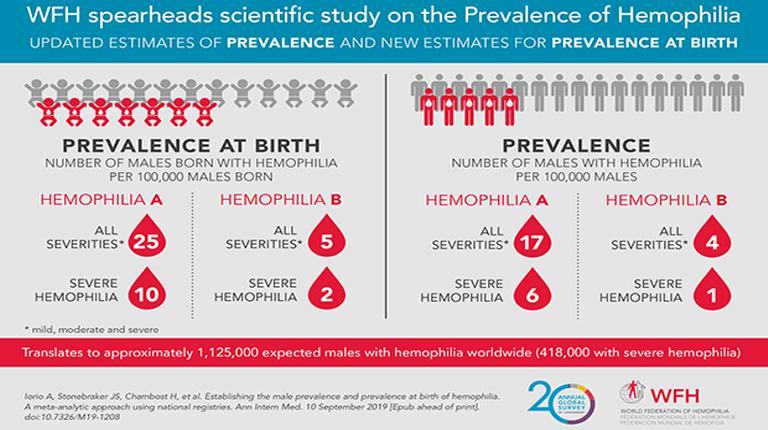Based on prevalence at birth, more than 1.1 million men and boys are born with hemophilia around the world. Most of these patients are not diagnosed and many do not live to adulthood due to hemophilia.
Those were the sobering insights uncovered by researchers who authored a major study spearheaded by the World Federation of Hemophilia (WFH). The numbers are well above previous estimates. The global estimate had been approximately 400,000.
The new data reveal a truer picture of the scope of hemophilia around the world, said Donna Coffin, WFH’s Director of Research and Public Policy. Seventeen of 100,000 males have Hemophilia A and four in every 100,000 have Hemophilia B, according to a study published in the Annals of Internal Medicine. Someone who has hemophilia needs regular treatment to prevent both serious bleeding and chronic bleeds that threaten a person’s joints and mobility.
“Knowing how many patients should be there, and how many less are reported to national and international registries is a measure of the work left to be done,” Dr. Alfonso Iorio, lead author and past-chair of the Data and Demographics committee of the WFH, told Hemophilia World.
The prevalence of hemophilia, especially in resource-poor countries, points to a heightened need for outreach and identification, Coffin said. Countries that lack healthcare resources need both training and diagnostic capability, she said. WFH, through its many programs, including the WFH Humanitarian Aid Program, aims to reach regions of the world that have urgent needs. CSL Behring has made a multiyear commitment to the WFH Humanitarian Aid program through donations of factor therapy.
The mission of the WFH is to “work to ensure every person – including those living with hemophilia and von Willebrand disease (VWD), those with rare factor deficiencies and women with bleeding disorders –have access to world-class care and recognition of their condition.” The organization and its network of national member organizations represent people who have hemophilia and other inherited bleeding disorders in 140 countries.
Marcus Carr, CSL Behring’s Vice President for R&D - Hematology/Thrombosis, said the recent publication in the Annals of Internal Medicine confirmed what many have long suspected – the incidence of hemophilia is higher than previously reported.
“The analysis presented in this recent study highlights that we still have significant work to do to ensure patients are diagnosed and have appropriate and adequate treatment available,” Carr said. “We at CSL Behring have an important role in meeting this challenge with our patients.”
Researchers from four universities in different parts of the world developed the new hemophilia estimates by analyzing patient registry data in Australia, Canada, France, Italy, New Zealand and the United Kingdom. By participating in patient registries, people who have hemophilia helped make a real contribution to what’s known about the illness, Coffin said. Patients opt in to registries, which collect “real world data” from patients about their health history. The data are typically de-identified and anonymized to protect patient privacy.
“The longer these registries exist, the better the data gets,” Coffin said. “They can contribute to enhancing patient care around the world.”



